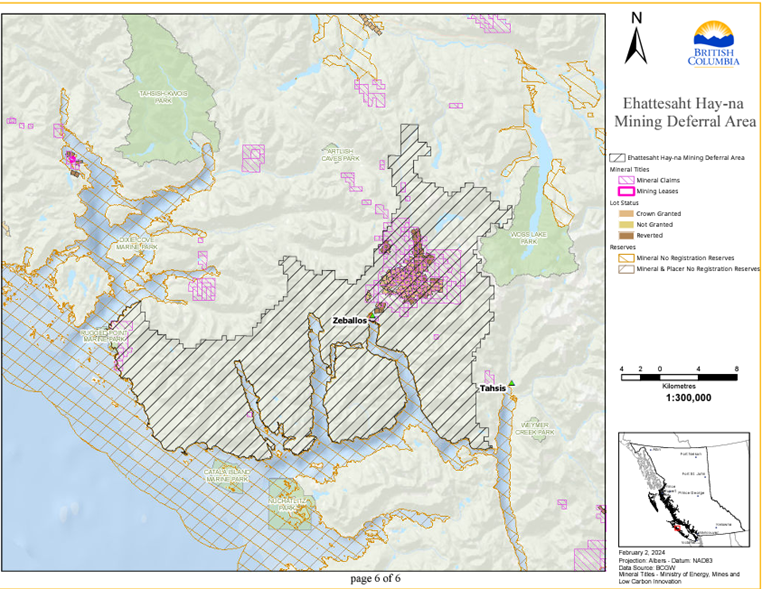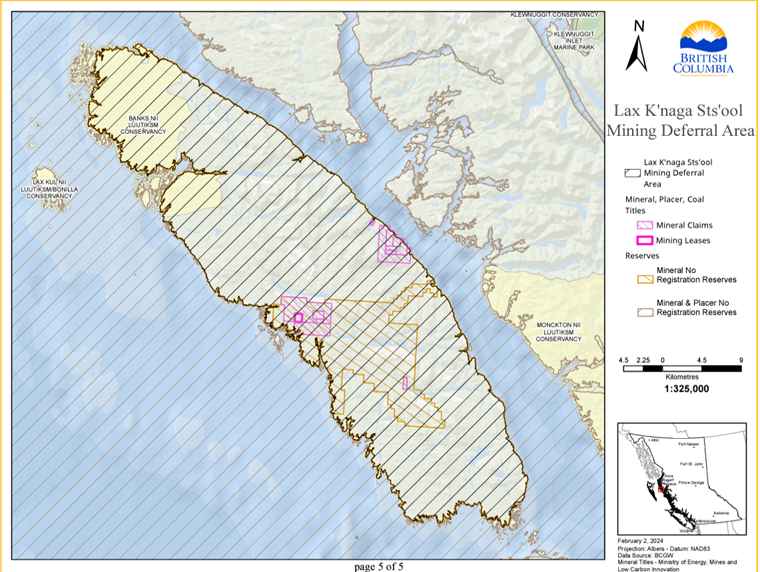[co-author: Brienne Gloeckler - Articling Student]
On March 7, 2024, British Columbia's Ministry of Energy, Mines and Low Carbon Innovation announced interim measures in the form of four Orders in Council1 (OICs). The OICs place restrictions on the issuance of mineral claims, leases and Mines Act permits, and mining activities, in designated areas located in Gitxaala Nation’s (Gitxaala) and Ehattesaht First Nation’s (Ehattesaht) traditional territories (collectively, the Deferral Areas). The OICs were issued pursuant to the broad authority granted to the Lieutenant Governor in Council (LGIC) under the Environmental and Land Use Act (ELUA).
The OICs implement the agreements between the province, Gitxaala and Ehattesaht relating to an appeal by the Gitxaala and Ehattesaht of the British Columbia Supreme Court’s decision in Gitxaala v British Columbia (Chief Gold Commissioner) (Gitxaala v. British Columbia). In that case, the Court required the Province to amend the Mineral Tenure Act (MTA) to consult with First Nations prior to issuing mineral claims. The OICs are intended to be in place until the Province modernizes the MTA to align it with the United Nations Declaration on the Rights of Indigenous Peoples (UNDRIP), as set out in the Province’s Declaration on the Rights of Indigenous Peoples Act (DRIPA) Action Plan and to respond to the decision in Gitxaala v. British Columbia.
On the same day, the province also announced its next steps on the engagement process for the modernization of the MTA.
Background
In Gitxaala v. British Columbia, Gitxaala and Ehattesaht challenged the implementation and validity of the MTA, alleging that the lack of mandated consultation prior to granting mineral claims breached the Crown’s duty to consult. The two Nations also asserted that the MTA is inconsistent with the rights recognized in UNDRIP and DRIPA.
The Court held that the Chief Gold Commissioner's failure to require pre-registration consultation breached the Crown's consultation obligations that it owed to Indigenous peoples. The Court required the province to amend the MTA to address this lack of pre-registration consultation within the next 18 months. Regarding the Nations assertions over UNDRIP and DRIPA, the Court held that section 3 of DRIPA does not require the Court to adjudicate whether British Columbia’s laws are consistent with DRIPA.
Following the decision, Gitxaala and Ehattesaht filed a Notice of Appeal at the British Columbia Court of Appeal seeking, among other things 1) a declaration that the Chief Gold Commissioner be prevented from allowing the registration of any mineral claims over territory which Gitxaala or Ehattesaht have asserted Aboriginal title without first consulting with the respective Nation; and 2) an order to quash specific mineral claims in their territories. The Nations also appealed the Court's findings regarding DRIPA and sought a declaration that the consistency of British Columbia's laws and DRIPA is a justiciable issue.
For more details on Gitxaala v. British Columbia and the appeal, see our previously published summary and analysis of the decision.
The OICs
Together, the OICs designate two areas, one within Ehattesaht territory and the other within Gitxaala territory as Deferral Areas in which mining activities are halted (see maps of the Deferral Areas in Figure 1 below).
The combined effects of the OICs are as follows:
- no new mineral claims or placer claims may be registered pursuant to the MTA in the Deferral Areas;
- no mining leases may be issued with an area entirely or partially within the Deferral Areas;
- no “mining activities” (including exploration, development and production of minerals), except activities related to reclamation, may be undertaken in the Deferral Areas by:
- registered holders of mineral claims or mineral leases that are partially or entirely within the Deferral Areas;
- holders of a free miner certificate who do not have a registered mineral claim or lease; or
- holders of a Crown granted 2 post claim that is partially or entirely within the Deferral Areas;
- no new Mines Act permits may be issued within the Deferral Areas and no exemption to the permit requirement may be granted;
- work, other than that relating to reclamation, authorized under specific existing Mines Act permits may not be carried out within the Deferral Areas; and
- upon request, expiry dates for claim holders of existing tenures are extended until after February 21, 2029, in certain instances.
Except for the prohibition on the registration of new mineral or placer claims under the MTA, which appears to be indefinite, the restrictions listed above are in place until February 21, 2029 (Deferral Period) if not amended or removed sooner. The province signaled in its news release that the OICs can be amended if Ehattesaht or Gitxaala reach an agreement with affected proponents, and presumably until the MTA is modernized.
The province sent notice of the restrictions to affected tenure holders, outlining the key elements of the OICs and some of their implications for mineral tenure holders.
Legislative Authorization
The OICs were made pursuant to ELUA. ELUA confers on Cabinet powers with respect to the environment or land use. It empowers the Environment and Land Use Committee (Committee), appointed by the LGIC, to, among other things, make recommendations to the LGIC respecting “any matter relating to the environment and the development and use of land and natural resources.” Section 7(1) of ELUA authorizes the LGIC, on the recommendation of the Committee, to implement such orders it “considers necessary or advisable”. Once an order has been issued, a minister, ministry or agent of the Crown must not “exercise a power under any other Act or regulation except in accordance with the order.” In effect, ELUA purports to allow the LGIC to override other legislation relating to the environment (which is broadly defined in section 1 as “all the external conditions or influences under which humans, animals and plants live or are developed”) and land use.
Previous orders issued under ELUA include those designating certain areas as protected areas and prohibiting mining activities in those areas. For example, in 2021, Order in Council 560/2021 designated an area as protected park land and prohibited mineral tenures, except for a specific existing tenure, from being registered within the area. Similarly, Order in Council 354/2021 renewed the Mountain Caribou Partnership General Deferral Area, in which various permits, including Mines Act permits, were prohibited from being issued for a period of time. Under section 14(1) of the MTA, recorded holders of mineral claims are prohibited from applying for any form of permission to conduct mining activities in protected areas.
Relying on the powers conferred by ELUA was likely the most expeditious route for the province to implement the restrictions on the mining industry. Notably, however, when ELUA was first introduced, critics raised the issue that while the legislation appears to confer very broad powers (ones that allow other laws to be overridden), ELUA does not contain concrete enough principles by which such powers must be exercised.2 Some public responses to the OICs thus far mirror this concern and question the validity of the broad legal authority granted pursuant to ELUA.
Implications and Next Steps
In response to the measures, Gitxaala and Ehattesaht have agreed not to proceed with the appeal to seek orders to prevent new mineral claim registrations or quash specific existing mineral claims in their territories. However, the relief sought on appeal in relation to DRIPA will likely still proceed as the OICs do not address these claims. Given the Province intended to modernize the MTA in line with UNDRIP, a negotiated outcome to resolve the existing and any new mineral claims and activities is arguably logical—why outlay resources arguing for an outcome that one intends to amend?
The OICs have raised many questions, including what is the path forward for those that hold tenure rights and have made the investments? The notice which the province provided to affected tenure holders did not address this, although the province has indicated it is, or has, invited affected stakeholders to enter into discussions with it. The Ehattesaht has also indicated its openness to discussions with proponents, noting that “[Ehattesaht is] not against mining, but if you want to mine here, we have to find ways that keep our lands and waters healthy and that respect [Ehattesaht’s] rights and culture.”
The OICs have raised questions relating to when restriction on the exercise of rights becomes an expropriation of those rights, and, when that line is crossed, when and how compensation should be provided. The use of the powers conferred by ELUA could signal that the province is comfortable in using these powers to more expeditiously implement those land use planning initiatives it deems in the public interest.
Next steps to reform the MTA will soon be underway. On March 7, 2024, the province announced it will commence consultation with First Nations and engagement with other stakeholders. Opportunities for engagement will occur through a public-facing website and through sessions with industry associations, local governments, and other interested groups. The Province’s announcement demonstrates an acknowledgment of the criticism it faced regarding the engagement process for the now paused Land Act amendments.
Figure 1: Deferral Areas3


1 Order in Council
110/2024,
111/2024,
112/2024, and
113/2024.
2 See, e.g., “Bill 82, Environment and Land Use Act”, 2
nd reading, British Columbia, Legislative Assembly, Hansard, 29 Parl, 2
nd Sess (23 March 1971) beginning at 754.
3 Order in Council number
0112/2024, Schedule B; Order in Council number
0113/2024, Schedule B.